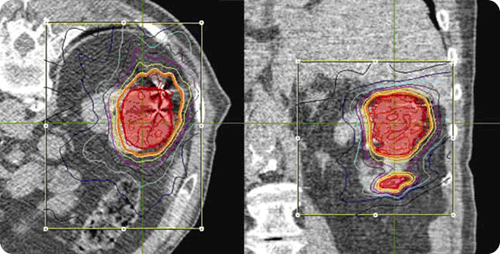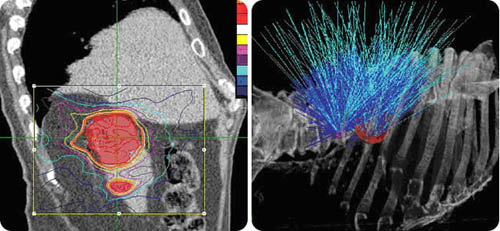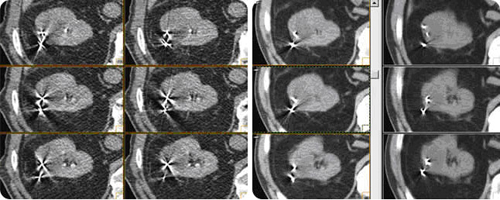Kidney cancer accounts for 3% of all adult malignancies and the rate of kidney cancer is increasing at 1.5% per year. In 2002, there were 208,280 newly diagnosed kidney cases and 101,895 cancer-related deaths worldwide. In 2006, an estimated 38,000 new kidney cancer cases will be diagnosed in the US with approximately 12,000 kidney cancer-related deaths. Men are twice as likely to be diagnosed with kidney cancer as women.
Renal cell carcinoma is the most common type of kidney cancer, representing 90% of all kidney cancer cases. Renal cell carcinoma is treated with radical or partial nephrectomy, sometimes performed laparoscopically. Radiofrequency ablation, cryoablation, and arterial embolization are all intended to selectively treat the tumor and spare functional kidney tissue. Cytokine therapy (IL-2, IN-a) and chemotherapy have also been employed, and although response rates are low, selected patients do respond.
Using the CyberKnife® System to treat kidney cancer:
Renal cell carcinomas are not very sensitive to small doses of radiation and normal kidney is extremely sensitive to radiation. High dose per fraction conformal stereotactic radiosurgery can achieve local control of small renal cell carcinomas. The CyberKnife® System is able to deliver hypofractionation regimens which have been shown to effectively treat renal cell carcinoma metastases to the spine.
Primary Renal Cell Carcinoma
(Courtesy St. Joseph's Hospital and Medical Center, Phoenix, AZ)


Axial/coronal (top) and sagittal (bottom left) treatment plan for two tumors in the right kidney imaged and treated in the prone position (NOTE: The CyberKnife® System does not support treating patients in the prone position; the decision to do so is the treating clinician's and is made independently of Accuray Incorporated). The right panel shows beam delivery for both tumors (light blue lines represent beams actually delivered). The right panel illustrates a treatment plan for the larger lesion with the 72% prescription isodose line in yellow.

Three months and nine months after CyberKnife® treatment (right) , CT scan of the abdomen revealed an unchanged 3-4 cm lesion (compare to the planning CT in left panels) in the upper pole of the right kidney with no evidence of retroperitoneal adenopathy and no evidence of recurrent tumor in the left renal fossa.
References
1.GLOBOCAN 2002 Database Lyon, France, 2002. LINK
2.American Cancer Society. Cancer Facts and Figures 2006. Atlanta: American Cancer Society, 2006. LINK
3.Sengupta S, Zincke H. Lessons learned in the surgical management of renal cell carcinoma. Urology 2005;66(5 Suppl):36-42. PubMed ABSTRACT
4.Wagner AA, Solomon SB, Su LM. Treatment of renal tumors with radiofrequency ablation. J Endourol 2005;19(6):643-52; discussion 52-3. PubMed ABSTRACT
5.Bleumer I, Oosterwijk E, De Mulder P, Mulders PF. Immunotherapy for renal cell carcinoma. Eur Urol 2003;44(1):65-75. PubMed ABSTRACT
6.Beitler JJ, Makara D, Silverman P, Lederman G. Definitive, high-dose-per-fraction, conformal, stereotactic external radiation for renal cell carcinoma. Am J Clin Oncol 2004;27(6):646-8. PubMed ABSTRACT
7.Gerszten PC, Burton SA, Ozhasoglu C, Vogel WJ, Welch WC, Baar J, et al. Stereotactic radiosurgery for spinal metastases from renal cell carcinoma. J Neurosurg Spine 2005;3(4):288-95. PubMed ABSTRACT